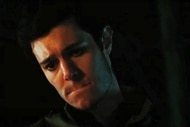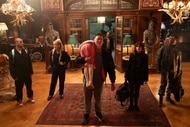Create a free profile to get unlimited access to exclusive videos, sweepstakes, and more!
Indie Comics Spotlight: 'MPLS Sound' honors the Revolution that was musical superhero Prince

Thirty-six years ago, the late artist known as Prince won an Oscar for Best Original Score for Purple Rain. His musical movie not only crossed genres to make him a household name, but showcased a slew of talented musicians like Morris Day and The Time, Wendy & Lisa, and more. Everyone who stood on stage with Prince was exceptionally gifted. That was by design, as every artist that came through Paisley Park was trained and coached by Prince himself.
The graphic novel MPLS Sound aims to capture Prince’s transcendent rise and the birth of the “Minneapolis sound” by telling the story of his influence through the fictional funk band Starchild.
MPLS, which came out in April, was one of Humanoids' last releases before publisher Mark Waid announced the company was pausing printing due to the pandemic. The 121-page graphic novel was co-written by Heavy Metal Magazine’s Executive Editor Joe Illidge and Hannibal Tabu (Noir Is the New Black) with art by comics newcomer Meredith Laxton.
The brainchild of former Humanoids editor and Fair Square Comics founder Fabrice Sapolsky, who assembled the creative team before leaving the company, MPLS Sound is a love letter to Prince fans everywhere. The story follows Theresa Booker, a (fictional) budding musician who fell in love with Prince as soon as she laid eyes on him. Inspired by his music, she pulls out her dad’s old guitar and practices until her fingers bleed. Theresa’s raw talent gets her noticed, but leading a band is where her heart is, and with the help of her brother, Ellis, she slowly builds Starchild and makes her dream a reality.
Set in Minneapolis in the early 1980s, the graphic novel is so realistic in location and tone that it’s hard to believe Starchild didn’t actually exist. MPLS Sound parallels the band’s journey with many prominent Prince protégés and contemporaries making appearances, including “His Royal Badness,” who styles and grooms the group at one point. But the dream isn’t all it's cracked up to be when the reality of being a Black woman leading a band in the ‘80s collides with egos, art, and fame.
Part music history, part magical journey, the creators achieved the incredible task of blending fictional characters with well-known, real-life musicians and giving us an unflinching look at the music business of the 1980s.
SYFY WIRE spoke with Illidge, Tabu, and Laxton about the research that went into MPLS Sound, their favorite Prince tracks, and how exactly one goes about drawing music.
Dig, if you will, the pictures.
Hannibal, you had mentioned before that your initial meeting with Fabrice was pretty funny. Can you explain?
Tabu: He invited me to the Humanoids offices and began to outline this ambitious publishing plan for Ignited and Omni and all these other [H1] books, and I got very excited. Then, he said, "Forget about all of that." I was very confused.
He had researched my music journalism in the 1990s with MTV and The Source, and figured I was the right person to start the MPLS creative process with.
Did you know that you would be drawing Prince when you first got involved with this project, Meredith?
Laxton: Early in 2018, Fabrice Sapolsky and I were introduced by a mutual friend, Tom Lyle, prior to a portfolio review. He had mentioned that he was looking for an artist to work on a book that featured a certain famous musical talent, but would not say who.
I was astonished to find out that Prince was one of many famous cameos I would have to draw. It was a lot of pressure, initially, because the likenesses had to be spot on.
Which was the longer process, developing the story or getting the character designs just right?
Illidge: The character designs are the genius of Meredith, whose art really helped me dig deeper into the world of Minneapolis during those years. Once the characters are visualized, they take on a new dimension for the writer.
Developing the story took a good while, and the story went through different permutations. The soul of the story is Theresa's journey, so it was a priority that her path rang true, that it dovetailed with history and with the experiences of Black people during that time.
This project was very heavily researched, it seems. Can you elaborate on that process?
Tabu: I did extensive interviews with two Minneapolis residents. One was a white woman who moved [to Minneapolis] in 2016, and the other was a Black woman who still lived there and was in her early thirties. Between the two of their experiences, I got a sense of the city.
I also read Let’s Go Crazy by Alan Light, Prince by Ronin Ro, I Would Die 4 U by Touré, and Prince by Eric Braun — and I listened to Jimmy Jam's interviews on Questlove's podcast.
How did you decide on the era of Prince’s career to place Theresa's story?
Illidge: The story Humanoids wanted us to tell had to precede the forming and debut of The Revolution, so we had to look at 1980 to 1983 as the timeline through which the drama unfolded. Considering how many things happened with music and the musicians that worked with Prince during those years, it allowed us a great opportunity to have Theresa go through a specific arc that echoed the experiences of others, but at a different speed with different characters and life nuances.
Tabu: Well, I didn’t want to cover "weird Prince" after the Cherry Moon phase, nor "struggle Prince" before Controversy, so we settled for him on the edge of the precipice, getting ready to fly. Fabrice found this as the most interesting period due to the many influences that came from it — Andre Cymone, Jimmy Jam and Terry Lewis, etc. We figured at the birth of the sound that would be the most interesting point to do this. Likewise, there are a lot of love songs written about how things begin or how they end. Middles often don’t have the same creative grist.
How did you approach drawing music?
Laxton: There was talk about possibly adding lyrics or musical intonations in the background, but, ultimately, the decision was made to leave the performance scenes silent. My thinking is that the visuals would be enough to invoke the idea of music and the reader would insert the sound elements through their imaginations.
There are epic cameos in this piece. Did you plan those going in?
Illidge: The cameos emerged naturally in the story. Without spoiling it for upcoming readers, every real musician or producer who appeared in the story served a purpose in pushing and pulling. There’s... a moment of truth, a painful truth. Prince's various appearances in the story were of high, overview import. For the other people, their impact is more ground-level.
What was the process like designing the newer characters?
Laxton: Hannibal had based Theresa and Ellis off people in his life and sent me descriptions and photos to work from. For the rest of the gang, I drew a lot of inspiration from other popular musicians and rock stars, but, more importantly, I wanted them to reflect people that I’ve known personally.
What is the biggest surprise in your research of Prince and his influence?
Illidge: The degree to which Prince controlled, and sometimes created, the music that other bands he curated would play in live performances. Prince's relationship with Morris Day and The Time reveals some of this. Prince's influence was so great that he shaped the public identities of other people as a natural part of his process, which is both impressive and unsettling.
Tabu: I was surprised to find out how stringently his colorism played into things, especially visible in some of the Brown Mark coverage. Before I started the project, I knew about how Prince was very generous with his philanthropy and politically active working toward the betterment of Black people, but to create that money and create a space, and he practically used the paper bag test.
It was a very odd dichotomy, but we are all complex people.
What's your favorite Prince song, and are there any Easter eggs in the comic?
Laxton: That is a really tough call. “Raspberry Beret,” “Nothing Compares 2 U,” and “Purple Rain” are some of my favorites. I listened to a lot of Prince while I worked on the pages, and at times, it got a little emotional. I tried to slip in some references to other artists as well. Like posters or photos on walls, but more specifically in the fashion choices of our main characters.
Tabu: It's a tie between “Thieves in the Temple” and “Housequake,” with a special place in my heart for “4 the Tears in Your Eyes.”
Illidge: It would be a tie between “Let's Go Crazy” and “Diamonds and Pearls.” There are no big Easter eggs in MPLS Sound, but we hope everyone enjoys this secret history that sat alongside our own. It's ultimately about the persistence of the creative spirit.





























